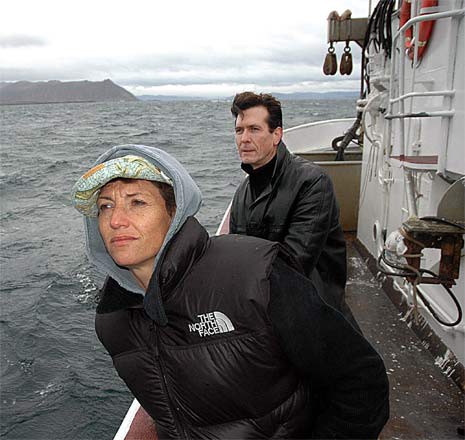When the Director Guild of America’s Women’s Steering Committee was officially
established in 1979, women comprised just 0.5% of episodic TV director
employment. One half of one percent! According to Guild lore, meetings opened
with the words “Fellow Directors and Mrs. Lupino.” At some
general meetings, the audience was referred to as “Gentlemen,” until the few
women members in attendance complained.
By 1979, a few more women had gained membership in the Guild, but they
frequently found themselves unable to land jobs. Frustrated, six of them (the “Original Six”) began assembling statistics.
The following year, they presented the results
of their research to Michael Franklin, then National Executive Secretary of the
DGA. Stunned by the numbers, he agreed that something had to be done. Franklin
was a labor leader in the old sense, and deeply concerned with discrimination
against women members of the DGA. He inspired the Guild’s conscience. He
brought the Board and the Guild to a higher level of responsibility and
accountability, struggling for a higher vision for all workers.
Franklin made it clear that the Guild would support the Original Six, and
together they went before the DGA’s National Board to request the formation of
a DGA Women’s Committee. He also tried to get the studios and TV production
companies to improve the hiring of women DGA members. The Guild, in conjunction
with the Women’s Committee, set up meeting after meeting to encourage
production companies to interview women members. They circulated directors’ reels, discussed possible “set-asides” (a specific number of directing slots
for women) — all to no avail.
These meetings were based only on voluntary
compliance and went on for a year with negligible results. The studios and
production companies were intransigent. Franklin became convinced that the only
effective strategy would be a legal one.
After one final attempt, when none of the invited executives showed up for a
scheduled meeting, a fed-up Franklin made his historic decision to launch the groundbreaking DGA-led, class-action
lawsuit against three major studios in 1983. It was time to sue, and the
Guild would lead the suit. The legal action was
groundbreaking because women directors in Hollywood had never before used U.S.
civil-rights laws to challenge gender discrimination.
For laymen, the leader of a class-action suit is a named party who brings the
suit on behalf of other potential class representatives. In the case of this
lawsuit, the women did not have the financial means to hire legal
representation sufficient to take on the studio giants. Therefore, the DGA very
generously offered to take on the lawsuit and act as the leading named
plaintiff.
However, a legal requirement of a class representative is that it must hold
interests that are typical of the rest of the class, and it must be able to
fairly and adequately represent all other members of the class. It was because
of these requirements — and not on the merits of the case — that in 1985, Judge
Pamela Rymer refused to assign class-action status to the case at that point in
time and disqualified the Guild from leading the class. The court found that
some of the Guild’s own policies discriminated against the very women they were
representing, which put the guild in a position of conflict of
interest.
Significantly, Rymer supported the validity of the case and stated that it
could continue without the DGA. Unfortunately, the women did not have the financial
means to finance the lawsuit and were forced to step down. Even so, this legal action led to a striking surge in the number of women TV directors, as well
as the creation of numerous DGA-Studio Agreements promoting diversity hiring.
By 1995, just 10 years later, the percentage of TV episodes directed by women
had risen from 0.5% to 16%. Sixteen percent! This was certainly thanks
to the crucial support that Michael Franklin and the DGA leadership provided
women Guild members at that time.
As Franklin himself stated in an article entitled “The Man Behind the Women’s Movement at the Guild,” “there were new
people in the positions of leadership within the Guild. People like Gil Cates,
Gene Reynolds, Jay Sandrich, Boris Sagal, Norman Jewison, Tom Donovan, John
Avildsen, Marilyn Jacobs, Enid Roth, Elia Kazan, Jane Schimel, Karl Genus, John
Rich, Arthur Hiller and Jackie Cooper. They merged together to support the [Women’s] committee, authorize funds and really move ahead in a broad
front” (DGA News 1990/1991).
Unbelievably, thirty years after the landmark lawsuit, the number of working women directors in the DGA has gone down. Today, only 12–14% of TV episodes are directed by women — an unfortunate reversal during a time of unprecedented industry growth and abundance, particularly in television. Why?
* * *
The problem lies in part in the squandered opportunities by the individuals who
are in leadership positions in the Directors Guild of America. The DGA
is a highly respected and powerful organization. When the DGA speaks, the
entertainment world listens. It is the only entity
in America that effectively has the power to demand gender equity among
directors in our industry because its primary function is to represent the creative
and economic rights of directors.
By its own admission, the DGA is the richest, most powerful Guild in our
industry. It is a well-funded organization that routinely enters into
collective bargaining negotiations with studios and producers on behalf of
directors, and it is the union that women directors who are already
professionals belong to. Our current DGA Executive Director, Jay Roth, is a
civil-rights expert and a brilliant lawyer who has successfully led
negotiations on the Guild’s major collective-bargaining agreements seven times
since becoming National Executive Director in 1995.
The DGA-Studio Collective Bargaining Negotiations take place every three years,
and Roth has succeeded in making many great forward strides for the interests of
all Guild members. In the recent 2014 round of negotiations, the Guild, under
his leadership, did include diversity as one of its four key issues. Some
advancements were made, including making it easier to arbitrate discrimination
in certain situations. For this achievement, he, and those who worked with him, should be
applauded.
Unfortunately, women remain buried within the general category of “diversity.” Under the new contract, the studios could continue to advance
diversity without advancing women. In fact, there is no legal obligation for
them to advance women in any way; the only legal requirement is that diversity
hiring improves. So women must rely on the good faith of studios and producers
to increase gender equity in hiring. But as we know, in the case of
women TV and feature directors, that good faith has not gone far and in fact
has resulted in a reversal of numbers.
In order for the agreement to benefit women, it must specifically refer to
women of all ethnicities as a separate class, in their own right. If women are
to be aided in this reach-out, then their employment numbers need to be
measured specifically and tracked. That can only be accomplished if the Guild
and the studios specifically break out women as a separate class.
Why do we have this paradox of declining stats even as the world has supposedly
become more enlightened about gender equity? The issue may point to a
sea change in the new media landscape. Originally, the Guild cared about a
sense of equality and fair play. Has that been lost or buried under more
pragmatic concerns, for instance the DGA Health Plan? New media? Piracy? Wages?
These issues have taken precedence in the past negotiations over the issues
of diversity, and especially the dismal progress of women DGA members.
It also may be true that the first surge in female
director employment was easier coming from the ridiculously low numbers of the
1970s, and after a decade or so, a certain complacency may have set in. And it
may be true that while the male membership of the DGA (in general an
enlightened and liberal body) favored gender equity in theory, they
may have balked at the prospect of sacrificing a piece of the pie. After all, director
employment is a zero-sum game to some extent.
Nonetheless, the subsequent growth of the industry should certainly have
resulted in more pie to share around. But putting food on the table
is a priority for artists, and a certain amount of selfishness can’t be helped.
For instance, even the women who have enjoyed the lion’s share of episodic TV
directing jobs in the past decades since the lawsuit do not seem to be making
efforts to help widen the job pool to include more, different women.
Some of the women who hold leadership positions in the Guild have
demonstrated little support for any change that could be construed
as controversial. This has resulted in a failure to get more women through the
door to TV directing. If those women are attempting to protect their turf, so
to speak, they are hindering the opportunity for our industry to work toward
equity among directors, they are perpetuating tokenism, and they are stifling
the hopes of the next generation of America’s women filmmakers.
Almost every woman director who is currently a DGA leader got her start after
the lawsuit, and therefore benefitted directly from the hard work and
sacrifices made by the Original Six who founded the Women’s Steering Committee.
Indeed, since all DGA diversity committees and efforts to support ethnic
minority hiring emerged from the work of these women, even our new DGA
President, Paris Barclay, who is African American, benefitted from their work. The
DGA African American Steering Committee was officially only established in
1994, nine years after the lawsuit.
* * *
Now, in 2014, as the numbers slip ominously backwards, it is not just women DGA
members we must look to for solutions. We must also understand why our male
leaders are failing to take on the power establishment that has so impeded the
potential of this generation of women filmmakers — and profoundly threatens
the next. If the problem is as ignoble as to be defined as a gender war for
resources, then we must bring to bear the laws of our great nation to insist
upon equity.
A high-level DGA executive recently said that if women directors press for more
work, they will be waging war, that they will be threatening to take the food
from the plates of the families of male directors. But women directors have
families, too, and it is only fair that the playing field for directing jobs be
level and free of gender bias.
Women directors must have the courage to speak out fearlessly if they
feel they have been “shut out.” In an industry based on personal relationships,
it is very hard for anyone to muster the courage to speak out against
discrimination. Fear of blacklisting is always present, but an industry — a
society — that condones fear is oppressive.
To solve this problem, women directors must openly demand the
advancement of women directors through the DGA and
studio and network diversity programs. We must help create a paradigm shift in
public thinking about the abilities and competence of women directors. We must
make the issue of the under-representation of women directors common knowledge.
We should seek out investigative journalists to expose conscious and
unconscious complicity within the Hollywood power establishment to keep women
out.
No one wants to bring lawsuits: they are bad for business, they are bad for careers,
they are time-consuming and expensive. But sometimes — like wars — they are
necessary, as was the case back in 1983. Hopefully, we do not need one now, but
we will have to see how sincere the commitments, and the intent of those
commitments, are as spelled out in the recent Collective Bargaining Agreements.
The possibility of future legal action rests in the hands of the DGA and the
studios. Let’s see if they can find it incumbent upon them to place social
justice and equity before fear of change.
Previously: “The New DGA/Studio Agreement: Nothing New for Women”
Maria Giese is a feature-film director, a member of the Directors Guild of America, and an activist for parity for women directors in Hollywood. She writes and lectures about the under-representation of women filmmakers in the United States.







